Subscribe to our newsletter
Citrofortunella

Calamondin is an important citrofortunella, meaning that it is an intergenetic hybrid between a member of the genus citrus (in this case probably the mandarin orange) and the kumquat belonging to Fortunella. Calamondin is used mainly as an ornamental tree, rather than for food, although the fruit is edible. Calamondin is called by many names, including: calamonding, calamondin orange, calamansi, calamandarin, golden lime, kalamunding, kalamansi, Philippine lime, Panama orange, Chinese orange, musk orange and acid orange. Calamondin is widely cultivated in the Philippines, there it is called: (Tagalog: kalamunding, calamansi or kalamansî [kɐlɐmɐnˈsɪʔ]; Visayan: limonsito or simuyaw [sɪˈmujɐw]), in Malaysia it is also known as limau kasturi and is growing also in the neighboring northern parts of Indonesia and southern China. It is available year-round in the Philippines and is usually seen in its unripened green state. When left to ripen it turns a tangerine orange.









